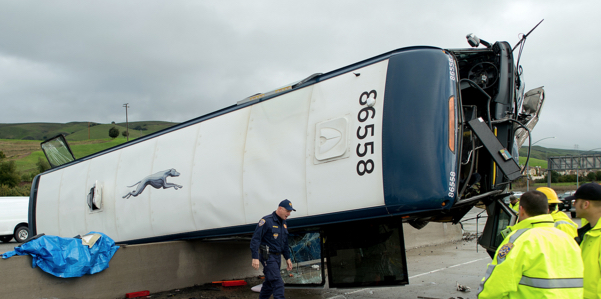
Today’s question comes from Marisol S. in South San Francisco who asks “my friend was on the Greyhound bus that crashed on Monday. They say that the driver may have been too tired and fell asleep. Isn’t the bus company supposed to make sure that the drivers aren’t drunk or falling asleep? How can they let someone who is falling asleep drive a bus? What laws apply? What are her rights?”
Marisol, when I awoke yesterday to hear of this tragedy, I thought to myself: This could have – and should have – been prevented. Fatigued or “drowsy” driving is a significant threat to public safety. According to the National Sleep Foundation, DrowsyDriving.org, a 2005 poll of Americans revealed that 60 percent of drivers – about 168 million people – admit to driving while feeling drowsy in the past year, and one-third or more – 103 million people – have actually fallen asleep behind the wheel.
The survey showed 13 percent admitted to doing so at least once a month. And approximately 4 percent – 11 million drivers – admit that exhaustion caused an accident or near accident as they either dozed off or were too fatigued to concentrate.
According to the Sleep Foundation and the U.S. National Highway Traffic Safety Administration (NHTSA), a conservative statistical estimate reveals approximately 100,000 police-reported crashes result from driver fatigue yearly. This translates to approximately 1,550 deaths, 71,000 injuries and $12.5 billion in associated financial losses. These statistics are likely to underreport the problem because, in contrast to driving while intoxicated, there is no test for fatigue.
Under law, commercial bus drivers/operations are “common carriers and owe passengers the highest degree of care” including the obligation to provide vehicles and drivers that are fit to transport passengers.
The Federal Motor Carrier Administration, a part of the United States Department of Transportation, is the federal agency responsible for creating regulations applicable to interstate transporters including trucks, buses, motor coaches and other passenger-carrying vehicles. They have issued “hours of service” regulations, which can be found in Part 395 of the Federal Motor Carrier Safety Regulations.
Anyone driving a commercial motor vehicle that a) weighs 10,001 pounds or more; b) has a gross vehicle weight rating or gross combination weight rating of 10,001 pounds or more; c) is designed or used to transport 16 or more passengers (including the driver) not for compensation; d) is designed or used to transport nine or more passengers (including the driver) for compensation; or e) is transporting hazardous materials in a quantity requiring placards must abide by the FMCA safety standards as set out in the Federal Motor Carrier Safety Act.
Drivers are limited to driving no more than 10 hours after an 8-hour rest period with a 15-hour “on duty” limit prohibiting driving after 15 hours of total work, following eight consecutive hours “off-duty.” Off-duty time is not included in the 15-hour limit. A driver may not operate a CMV after 60 to 70 hours of on-duty time in any consecutive seven- or eight-day period.
Drivers are required by law to keep “driver logs” that record daily on-duty, standby and off-duty hours. These logs are supposed to be with the driver during operation of a vehicle for inspection by the California Highway Patrol or local police. There is no computer database tracking driver time, so law enforcement must rely on the drivers’ logs that, unfortunately, are sometimes fraudulently maintained to make it look like the driver is in compliance when he or she is not.
We have seen cases in which there are two log books: one for the police, and one for the employer – who often pays by the hour. Employers have an obligation to monitor employee drivers’ adherence to these regulations.
The Federal Motor Carrier Safety Act provides regulations for medical examinations of drivers to try and identify physical conditions or disabilities, which, based on safety criteria, may render an operator unfit to operate a CMV. These conditions include serious and uncorrectable vision conditions, narcolepsy, epilepsy, dizziness, fainting, problems associated with heart conditions and high blood pressure, the latter of which may lead to emergency events like a heart attack, neurological deficits such as impaired equilibrium, delayed reflexes, poor coordination or cognitive limitations.
You can rest assured the driver in this case was drug tested within two hours of the crash, and a review of his logbooks is underway. As these cases are very fact-intensive and require knowledge of the applicable state and federal regulations, your friend should contact a trial lawyer as soon as possible.
We have handled many similar injury and/or death cases before and can provide additional information and guidance to help victims protect their rights and seek recovery of their medical expenses, lost wages, etc.
This article was written by Chris Dolan and published by The San Francisco Examiner. To read all of Chris’ articles on the law published by the Examiner click here.










